How and what is the waterproofing of sewer wells
One of the most common ways to construct a sewer system in a private house is the construction of a concrete septic tank. At the same time, not everyone is asking about its tightness.
But in vain, because properly executed waterproofing of sewer wells will not only extend their service life, but also protect the soil from pollution. Let's figure out why you need to waterproof the sewer and how to do it right.
The content of the article:
Why waterproof a sewer well?
A serious mistake is made by those who believe that the work related to sealing the sewer well can be neglected.
In the best case, there will be severe pollution of groundwater, and in the worst - septic tank made of concrete rings will collapse in a few years.
There are several reasons why a well’s waterproofing should not be neglected:
- Corrosion of the reinforcing component of reinforced concrete rings. As a result of the formation of foci of rust on the reinforcement elements, the bearing capacity of the well shaft, which is constantly exposed to the pressure of the surrounding soil, is significantly reduced.
- The weakening of the concrete walls of the mine. Wastewater and groundwater contain chemically aggressive substances that adversely affect the structure of concrete. Over time, under their action, shells and cracks form, leading to the destruction of concrete.
- The likelihood of sewage infiltration.The walls of a concrete mine with caverns and cracks will not be able to prevent the infiltration of wastewater into the surrounding soil. Which ultimately will lead to a critical change in the ecological balance.
- Depressurization of joints.Concrete that has absorbed water during the frosty period will slightly increase in size. Imperceptible visually “movements” of concrete rings will become a serious threat to the joints of the mine assembled from them.
- Concrete destruction. Freezing the binder component of concrete stone at subzero temperatures, especially in the zone of seasonal freezing of the soil, leads to a rapid breakdown of bonds in the monolithic massif. For this reason, the well will last two to three times less than the prescribed period.
If everything is clear with the protective properties of waterproofing, then there is another important reason for sealing the sewer well. We are talking about floods and groundwater, the level of which during the period of active snowmelt and heavy rains becomes significantly higher.
Flood and groundwater can cause premature filling of the well, as concrete without waterproofing is able to pass water. As a result, it will be necessary to pump out using special equipment.
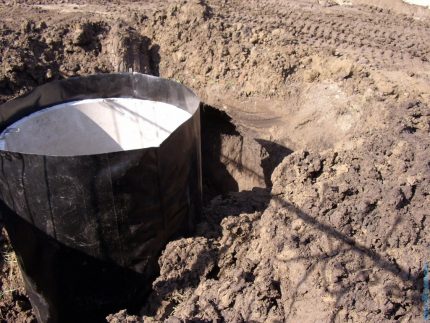
Work on the isolation of sewer wells can be divided into two main types:
- Internal waterproofing;
- External waterproofing.
It is recommended to simultaneously carry out internal and external waterproofing, which will maximize the protection of the well walls from erosion, and the soil and groundwater from pollution.
Exterior insulation work
The main objective of such waterproofing is to minimize or completely eliminate contact of the external walls of the septic tank with groundwater.
It is best to perform the work at the stage of construction of the well. If this is not done on time, then a significant amount of excavation will have to be done.
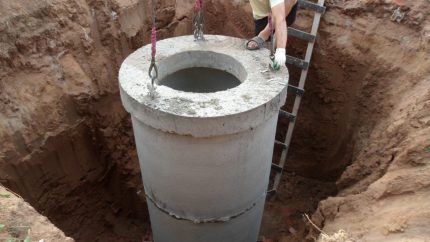
Waterproofing with bituminous materials
For external waterproofing, bituminous mastics and bituminous roll materials are used:
- On a cleaned and prepared surface it is necessary to apply a composition of 3 parts gasoline and 1 part bitumen. The mixture should be applied using a compressor by spraying, but you can restrict yourself to a regular brush.
- For maximum sealing of the seams, they should be glued with concrete-rubber tape.
- After the first primer layer has dried, it is necessary to prepare the concrete rings - to repair chips and potholes until a smooth surface is obtained. To fill the sinks, it is best to use a mixture of PVA glue with a cement-sand mortar in a ratio of 1 to 5, but you can limit yourself to a regular cement mortar.
- After the cement has dried, it is necessary to apply another layer of soil from a bitumen-gasoline mixture, but already in a ratio of 1 to 1.
- The next step will be the application of mastic, it is better to use tar mastic, since bitumen is easily peeled off. You can also apply coated bituminous mastics with polymer additives.
- It remains to apply 3-4 layers of roll materials (roofing material), carefully gluing the joints.
- Upon completion of work, it is necessary to backfill the soil, if necessary, arrange a clay castle and concrete blind area.
The main advantage of well waterproofing with bituminous materials is the simplicity of the work and the low cost of the material. At the same time, the work execution technology should be strictly adhered to, since a violation of the proportion of the bitumen-gasoline mixture can cause premature destruction of the protective layer.
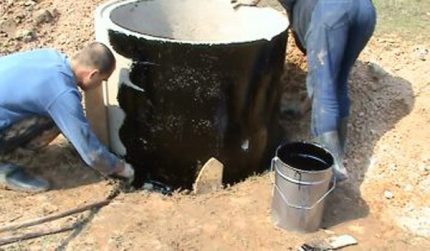
Penetrating application
Penetrating waterproofing is a good alternative to bitumen materials. True, for its use requires a more thorough preparation of the concrete surface with the elimination of all irregularities and grinding.
At the same time, grinding is best done by sandblasting, which will maximize the pores of concrete.
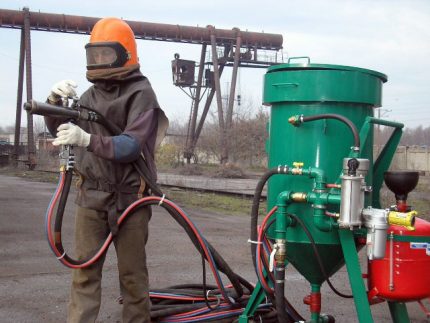
After grinding concrete, the primer is not performed. Before applying waterproofing of deep penetration, it is necessary to moisten the treated surface well.
It is best to give preference to the proven primer Penetron, Kalmatron, KtTron, but you can restrict yourself to cheaper analogues like Elacor-PU.
Waterproofing should be applied with a sponge or a brush with a stiff brush. The drying time of the composition is three days. At the same time, during the drying process, it is necessary to moisten the surface in order to avoid cracking, and in hot weather, it is necessary to moisturize every 3-4 hours.
After the first coat has dried, another coat of waterproofing should be applied. Smears can be done with a brush or spatula, they should be directed perpendicular to the previous strokes. It is important to ensure that during the freezing period the surface is not exposed to mechanical damage and drying out.

Stucco under pressure
When shotcrete with cement, the surface of concrete rings does not need preliminary preparation. Using a cement gun providing a minimum pressure of 4 atmospheres, a cement layer of 5-10 mm thickness is applied. High pressure ensures maximum cement compaction and reduced porosity.
Cement coating needs periodic wetting (3-4 hours in hot weather and 10-12 hours under normal conditions). After 10-12 days, it is necessary to repeat the shotcreting and apply another layer of cement.
Arrangement of a clay castle
If it is not possible to isolate the upper rings of the sewer well with expensive means, ordinary crumpled clay is suitable. The principle of the concrete wall protection device is similar to the arrangement of drinking water wells with clay locks.
Only a layer of clay is laid in a narrower trench around the mine, because it is not necessary to protect runoff from atmospheric precipitation and flood waters.
Clay castle is best done in the spring in warm, dry weather. You can use the clay that was extracted during the construction of the well. In this case, sand impurities and stone residues must be removed.
At the first stage, it is necessary to free up the space around the rings with a thickness of 20-25 cm to a depth of about 2 m. Initially, the resulting gap must be filled with moist and greasy clay, carefully ramming it.
Next, you need to remove the layer of earth 30 cm thick in a radius of 1-2 m from the wall of the ring. The resulting space must be filled layer by layer with clay, laying it in layers of 8-10 cm. Each of the stacked layers must be well compacted. The resulting clay castle will minimize the contact of the outer walls of the well with flood waters and precipitation.
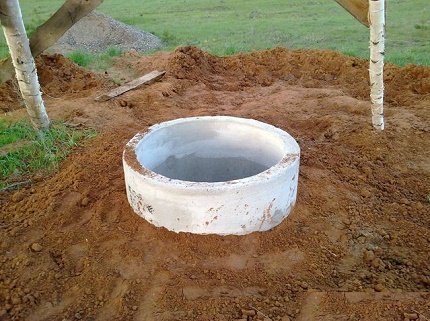
After a couple of years, when the soil is compacted and sagged as much as possible, you can proceed to the construction of a concrete blind area. To do this, you need to install the formwork, backfill with cement-gravel mixture in a ratio of 1 to 10.
The thickness of the backfill should be 0.1-0.15 m, it must be well sealed. It remains to prepare concrete and pour.
Well waterproofing
For internal waterproofing, the following materials can be used:
- cement putty;
- bitumen-gasoline mastic or molten bitumen;
- cement-polymer composition;
- bitumen-polymer mixture;
- polymer waterproofing.
Internal waterproofing of a sewer well can be made shortly before its operation.
Before carrying out waterproofing work, the well must be dried. The surface of concrete should be cleaned of dirt and dust, if necessary, grinding.
Cracks, joints and cracks need to be expanded to 20-30 mm, cleaned with a metal brush and repaired with a cement-polymer mixture.
Cement waterproofing
For waterproofing a septic tank, it is best to use a ready-made mixture, which is sufficient to dilute with water in accordance with the instructions. The resulting composition must be applied with a spatula for 2-3 times so that a layer with a thickness of 6-8 mm is formed.
After applying the last coat, the surface must be moistened and the well closed with a lid. Depending on the temperature, the drying time of the waterproofing layer can be 4-5 days.
During this time, you need to open the well 3-4 times a day and moisten the inner surface. The service life of cement insulation is up to 15 years.
Most often, a cement mixture is used to isolate joints before applying finish waterproofing.
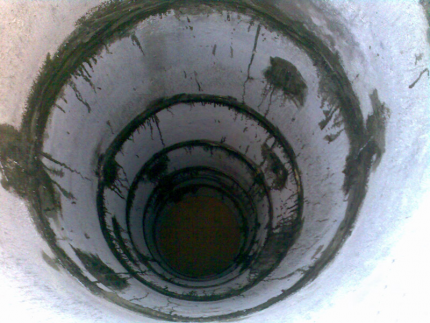
Application of bitumen-gasoline paint
The work is carried out in the same way as with the installation of a similar external waterproofing. The mixture is applied in three layers, the hardening time of each of the layers is about 12 hours. This type of waterproofing is not durable, the service life does not exceed 10 years.
If instead of bitumen-gasoline painting, two layers of bitumen mastic are applied and the roll insulation is fused, then the service life can be tripled. You should work as carefully as possible and ensure the ventilation of the well, since surfacing inside is associated with a certain risk.
Waterproofing with cement-polymer composition
Penetrating cement-polymer mixtures are one of the most modern and effective methods of waterproofing. Best proven mixes from the Greek company ISOMAT. They are environmentally friendly and durable.
Since environmental cleanliness is not as important in a septic tank as in a well, internal waterproofing can also be done with cheaper penetrating coatings Penetron Admix or Penecrit.The mixture must be applied in 3 layers with a spatula. Cement-polymer waterproofing will last at least 40 years.
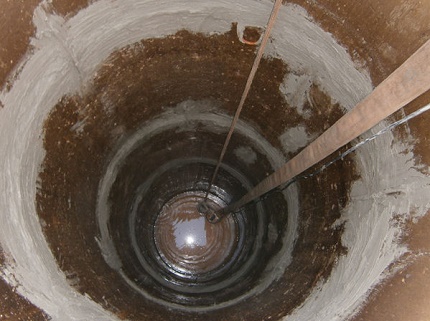
If you use the two-component mixture CeresitCR 166 as insulation, you can increase the service life of the waterproofing layer up to 60 years. The prepared mixture must be applied to a moistened concrete surface without efflorescence with a brush head.
On the first, not yet frozen layer, it is necessary to lay a reinforcing mesh and apply a second layer of the mixture. The two-component composition of CeresitCR 166 is highly elastic, which reduces the risk of destruction of the waterproofing as a result of a small displacement of the rings or their deformation.
The use of polymer blends
This material is the most expensive, but at the same time the most effective. The use of polymer mixtures will be justified for unstable septic tanks in which ring deformation is observed. Maximum efficiency is ensured by high elasticity achieved by installing the membrane on special mastics.
The best-known film polymer membrane. First, concrete rings must be treated with special mastic and left for 24 hours. The film has an adhesive base, it is enough to expand the roll, press the film to the surface and smooth it to remove air bubbles. The service life of insulation from a polymer membrane reaches 50 years.
The use of plastic inserts
One of the most reliable and easiest ways to waterproof a sewer well is to use a multilayer polymer or plastic insert. It has the shape of a cylinder, equipped with a bottom, a lid and a neck. The insertion height reaches 4.5 m, and the diameter can be 90 cm, 140 cm, 190 cm.
The wall thickness of the insert varies between 8-25 mm, depending on the manufacturer. To prevent deformation, the inserts are reinforced with stiffeners. Installation is very simple, just drop it plastic insert into the well and fill the space between the walls of the insert and the concrete ring with a dry cement-sand mixture.
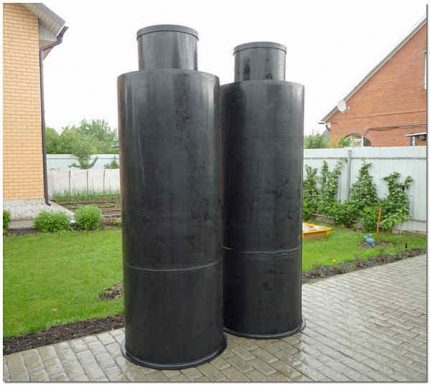
Sealing joints between concrete rings
Whatever the method of waterproofing the septic tank from concrete rings, it will not be able to provide complete tightness without the mandatory processing of joints between the rings. Even at the stage of installation work between the rings should be laid waterproofing and shock absorbing gasket.
It is best to use a concrete-rubber gasket. Granules of concrete clay present in its composition, upon contact with water, are able to increase their volume by 3-4 times. This clay reaction allows you to fill as much as possible the cracks and voids present between the concrete rings of the sewer well.
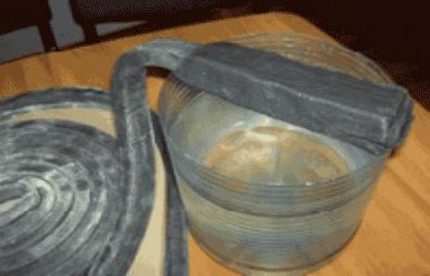
Concrete-rubber gasket has a high level of ductility. This quality allows you to maintain the tightness of the septic tank even in the case of a slight displacement of concrete rings. Spend joint sealing It follows not only between the rings, but also when mounting the first ring on a concrete base.
You can do it easier and instead of an expensive concrete-rubber pad, put the usual hemp, jute or linen ropes. The ropes themselves will not ensure the tightness of the seam, so they need to be impregnated with fiber rubber.Ropes should be laid on a polymer-cement mixture, which can be replaced with a mixture of cement with PVA glue.
Conclusions and useful video on the topic
Installation of the lower ring on a plate treated with a single-component composition
Clay lock device around a concrete barrel:
Installation of a plastic insert in the shaft of a sewer well:
Whatever method is chosen for waterproofing sewer well, all work must be performed with maximum quality. The slightest defect can cause the destruction of the insulating layer and will inevitably lead to the need for repeated waterproofing.
If you have already had to carry out work on waterproofing a sewer well in your own area, tell us which method you chose and what came of it. Perhaps you know some nuances that need to be considered when conducting waterproofing work? Please leave your comments, share tips, ask questions in the block under the article.

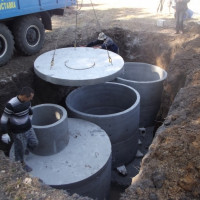 Reinforced concrete rings for wells: types, marking, production nuances + the best offers on the market
Reinforced concrete rings for wells: types, marking, production nuances + the best offers on the market 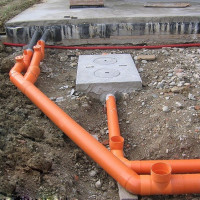 Laying sewer pipes in the ground: technological rules and nuances
Laying sewer pipes in the ground: technological rules and nuances 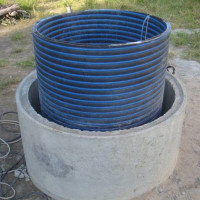 Inserting into a concrete septic tank: how to waterproof with a plastic insert
Inserting into a concrete septic tank: how to waterproof with a plastic insert 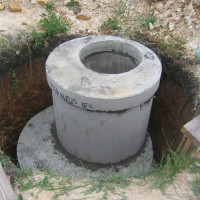 How to make a sewer well: do-it-yourself installation and installation
How to make a sewer well: do-it-yourself installation and installation 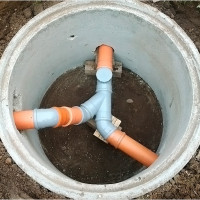 Manhole for sewage: installation of a well in storm and sewage systems
Manhole for sewage: installation of a well in storm and sewage systems 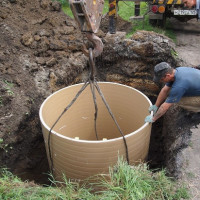 Viewing wells for drainage: types, arrangement and installation features
Viewing wells for drainage: types, arrangement and installation features  How much does it cost to connect gas to a private house: the price of organizing gas supply
How much does it cost to connect gas to a private house: the price of organizing gas supply  The best washing machines with dryer: model rating and customer tips
The best washing machines with dryer: model rating and customer tips  What is the color temperature of light and the nuances of choosing the temperature of the lamps to suit your needs
What is the color temperature of light and the nuances of choosing the temperature of the lamps to suit your needs  Replacement of a geyser in an apartment: replacement paperwork + basic norms and requirements
Replacement of a geyser in an apartment: replacement paperwork + basic norms and requirements
We did waterproofing (internal and external) to increase the life of the sewer well and its sealing. I think you should not neglect and save on this - it can become more expensive later. All the work was carried out by a team that was involved in the installation of a sewer well. They generally advised us to do waterproofing. Have not regretted once.
I bought a private house, where there was already a sewer well. Apparently, something is wrong there or with a seal, or another problem, but the bottom line is that with moderate use, the sewer is quickly filled, especially in autumn and spring. Then generally it is necessary to pump out almost every month. Tell me, can I somehow solve the problems without changing the entire well from scratch?
You left quite a bit of input to make unambiguous conclusions. I would like more details - how you have a sewage system: a sealed concrete cylinder or a septic tank with a drain.
Judging by the fact that the situation is most actively manifested in spring and autumn, the case may well be in violation of sealing. In this case, you need to look for a leak and fix it. Most often, the matter is improper sealing of the seams.
However, the problem may well be in another - there is a likelihood of siltation of the sewer or salting and the filling of the walls and bottom with organic fats. In this case, the cleaning and use of special biological products will help.
Hello. We had the same problem and its essence is really that in spring and autumn the level of groundwater is higher. Due to sealing problems with this problem, it quickly fills up. As a solution, equip a second pit for overflow nearby. If it is a matter of sealing, then it will not be possible to solve something “peacefully” already.
An “eternal” plastic well, this is good, but nothing lasts forever. How many years will really serve? And what are the operating conditions?
It is reliably known for now that plastic rings for a well do not lose their properties after 50 years of operation.It’s too early to declare a longer term, because due to the fact that the material is new, there is no practical evidence.
At the same time, concrete rings have been successfully operating for more than 70 years, as an example of this are wells laid in the postwar years. But the concrete rings are quite heavy, the weight of one with a meter diameter and the same height is 600 kg. Which makes installation very difficult.
But all the same, plastic rings are installed inside the concrete, although now there are more durable options for which protection from concrete is not needed. Manufacturers claim a longer service life than concrete, but then time will tell, as they say.